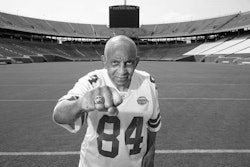An Unappealing Decision
Experts view U.S. Circuit Court panel’s reversal of Cureton v. NCAA as maintaining a ‘discriminatory status quo’ in collegiate sports
By Eric St. John
WASHINGTON — The NCAA “is free to discriminate.” That is how some experts are interpreting the decision of a three-judge panel of the 3rd U.S. Circuit Court of Appeals that ruled last month to deflate a lower court finding that the National Collegiate Athletics Association’s freshmen eligibility regulations have a disproportionately negative impact on African American student athletes.
“In very simple terms, what this court ruling says is that the NCAA cannot be sued under the [federal] Civil Rights laws and that it is free to discriminate,” says Adele Kimmel, an attorney with the Trial Lawyers for Public Justice. She is also one of the attorney’s representing the plaintiffs in Cureton v. NCAA.
The appeals panel ruled, by a 2-1 vote, that since the only direct federal funds the NCAA gets is for its National Youth Sports Program, that is the only program that is subject to challenge from federal Civil Rights laws.
Naturally, the NCAA has expressed satisfaction with the ruling.
“The effect of this ruling is that the association’s initial-eligibility bylaws remain in effect, and two more important jurisdictional questions have been answered with regard to the application of federal law to the NCAA,” says Dr. Graham B. Spanier, chair of the NCAA Division I Board of Directors and president of Pennsylvania State University.
But the decision did not address the plaintiffs’ argument that African American student-athletes are unfairly affected by the initial-eligibility rules. Those rules require entering Division I freshmen to have successfully completed at least 13 core academic courses in high school, achieving predetermined minimum grade-point averages and test scores on the ACT or SAT. Students who failed to get at least 820 on the SAT or 66 on the ACT could not play collegiate sports as a freshman. The court said that because of its determinations about Title VI, it was unnecessary to address the other issues raised on appeal.
That position, however, doesn’t sit well with many in the world of collegiate sports. They would like to see those issues of access addressed.
“The whole panorama of edicts and laws and rules and regulations by the NCAA needs to be investigated and talked about,” says Dr. Dick Barnett, president of the Athletic Role Model Educational Institute in New York, “especially in terms of the young men and women [being denied access to participation] in collegiate sports.”
Despite the ruling, the NCAA says this is not necessarily the last word on the requirements.
“We are pleased to obtain this ruling from the court,” Spanier says. “But as we have said all along, we will continue to review initial-eligibility rules, including the test-score cutoff.”
But Kimmel is concerned about the consequences if the ruling is allowed to stand: “It can have a ripple effect on any suit against any organization that is accused of having rules that have a discriminatory effect — whether its race, ethnic, sex, disability or AIDS discrimination.”
According to Kimmel, the court cited two grounds for ruling in the NCAA’s favor: “First, it held that the NCAA does not exercise controlling authority over its member schools’ intercollegiate athletics programs.”
The panel reasoned, Kimmel says, that the association’s member schools did not have to belong to the NCAA. And, it relied on the U.S. Supreme Court decision in the Tarkanian case, which ruled out the possibility of a suit against the NCAA in that particular instance. That 1980s piece of litigation involved a suit against the NCAA after University of Nevada-Las Vegas Basketball Coach Jerry Tarkanian stepped down following allegations of impropriety and the imposition of NCAA penalties against the university.
But the appeals court panel overlooked last year’s U.S. Supreme Court decision in Smith v. NCAA, “a Title IX sexual discrimination complaint,” Kimmel says, “in which the court specifically left open the possibility that the NCAA could be deemed to have controlling authority over its members schools.”
And Kimmel says the 3rd U.S. Circuit Court of Appeals panel should have known about Smith v. NCAA because “they had decided that case [previously] and they were reversed by the Supreme Court. They knew it very well.”
She then diplomatically added, “They either misinterpreted it or they misunderstood it.”
Kimmel says the second point used in the NCAA’s favor involves the scope of the regulation — Title VI of the Civil Rights Act — under which the initial challenge was filed. While the appellate panel limits the law’s coverage to a specific program within the organization, Kimmel notes that federal regulatory agencies and other circuit courts apply the law to entire institutions even if the entire institution is not receiving federal funds.
“We believe the court has interpreted the regulations very narrowly,” she says, “unlike the statute itself, which they admit has broad coverage.”
Additionally, Kimmel notes that in the NCAA’s appeal of U.S. District Judge Ronald Buckwalter’s ruling, the association — aware of federal policy on the matter — only made passing reference to the point that its only program to receive federal funding is the National Youth Sports Program. The 60-page brief filed by the NCAA with the appeals court includes only two paragraphs devoted to the specified funding, Kimmel says. And in the plaintiff’s reply, “we mentioned it in a footnote,” she adds.
As a result, “The court did not have the benefit of a full briefing on [the matter]. If they had, we believe they would not have come to this erroneous decision,” Kimmel says.
Buckwalter’s initial ruling in the case last March struck down the association’s freshmen eligibility standards — originally known as Proposition 48 but now referred to as Proposition 16. He said, in his decision, that the rule “has an unjustified disparate impact against African Americans.”
Buckwalter noted that the association’s own documents admit that the disparity exists and suggest that there are alternative ways for the organization to meet its goals of increased retention and graduation rates. He pointed out that the NCAA already had circulated a memo that offers three alternatives to Proposition 16 that are “less” racially disproportionate “while still serving the NCAA’s goal of raising student-athlete graduation rates.”
In the 54-page ruling, the judge said that the association “never [disputed] the veracity of the statements made in their own documents. These admissions and the bare statistics themselves plainly evince that African Americans” were being unfairly impacted by the NCAA’s regulations.
Additionally, Buckwalter said that the NCAA “has not produced any evidence demonstrating that the [college entrance exam] cutoff score used in Proposition 16 serves, in a significant way, the goal of raising student-athlete graduation rates.”
Buckwalter also ruled that the NCAA could be sued because the organization’s “member schools (who themselves receive federal funds) have ceded controlling authority over federally funded programs to the NCAA.”
He wrote: “While each of the member schools is also undeniably subject to Title VI for a challenge to Proposition 16, the NCAA, in light of the fact that it is the decisionmaking and enforcement entity behind legislation adopted by, and enforced against, its membership, is also subject to Title VI.”
Buckwalter held that the NCAA could also be sued because it was the “indirect recipient” of millions of dollars paid annually by the U.S. Department of Health and Human Services to the National Youth Sports Program Fund. The program, according to the judge, was “merely a conduit through which the NCAA makes all of the decisions about …the use of the federal funds.”
“This is an enormous victory for African American student-athletes and all who care about equality,” Andre Dennis, lead attorney for the plaintiffs, said at the time. “The court has confirmed what we’ve said all along — that federal law prohibits the NCAA from discriminating, that the NCAA’s minimum test score requirement discriminates against African American student-athletes, and that equally effective, nondiscriminatory alternatives are available.”
So now, it’s the plaintiffs’ turn to appeal. Kimmel says they will petition for either the three-judge panel to reconsider the ruling or for a hearing en banc — before the entire 11-member appellate court bench. If they are denied both requests or if the panel’s decision is upheld, the next step is the U.S. Supreme Court.
But that may not help the plaintiffs. The original pair who brought the suit, Tae Kwan Cureton and Leatrice Shaw are nearing the end of their undergraduate careers. The pair — who are Black, were seniors at Philadelphia’s Simon Gratz High School in 1996, and participated in track and field — had GPAs of 3.5 and 2.8, respectively, placing them in the top 10 percent of their 305-student class. However, both failed to achieve 820 on the SATs, disqualifying them for athletic scholarships under NCAA rules. Cureton currently attends Wheaton College in Massachusetts and Shaw attends the University of Miami. Both are seniors.
Two other plaintiffs were added later — Alexander Wesley, currently a sophomore at Temple University, and Andrea Gardner, a sophomore at Howard University.
“Unfortunately, [these appeals] mean that for some of these kids, they will have graduated before its over and will not get the benefit of the lost year of eligibility,” Kimmel says. “For Leatrice [Shaw], we need to get a ruling by the end of the [academic] year for her to benefit.
“But on the bigger picture, we’re talking about another year that hundreds and hundreds of African American student-athletes will have to apply to college under these unfair regulations,” she adds. “This is just a continuation of the discriminatory status quo.”
© Copyright 2005 by DiverseEducation.com


















